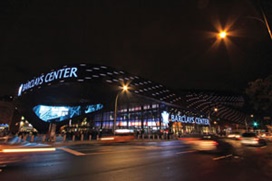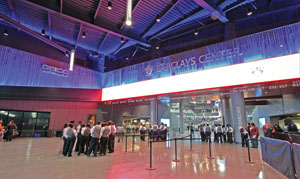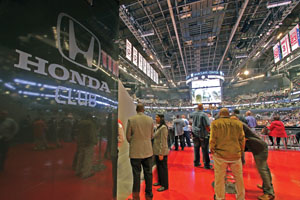|
| Executive Editor Abraham Madkour and Facilities Writer Don Muret on the opening of the new Barclay's Center. |
Barclays Center’s exterior frame of weathered steel firmly welds the new arena to Brooklyn’s industrial heritage, but the first thing that catches an observer’s eye is something new: the oculus, an age-old architectural element, updated for the digital age.
A broad loop of steel, sweeping and curving above an outdoor plaza as it extends from the building, has built into it Barclays Center’s signature marquee, a 3,000-foot LED board that can be seen from a distance down Flatbush Avenue. It is unlike any other digital billboard at a sports facility.
For an arena that celebrates Brooklyn’s sports and food traditions, the oculus stands out for its cutting-edge look. It’s a glimpse of the future, provided by an arena that once looked like it didn’t have one.
For the past decade, the Nets fought several opponents to build New York’s first new arena since Madison Square Garden opened in 1968. Their foes included both neighborhood residents and businesses whose buildings would be torn down and the recession, which put the project on hold for a few years.
Now the Nets see the oculus as a focal point for that community, providing information on arena events within a flexible space that can be used for pregame functions, said Hal Johnson, senior project director for AECOM, the sports designer that teamed with local architect SHoP to develop the arena.
In addition, the sign brings the arena’s founding partners to life. It is part of a “street to seat” strategy for communicating messages from the plaza to the inner bowl, said Brett Yormark, CEO of Brooklyn Sports & Entertainment, parent firm of Barclays Center and the Brooklyn Nets.
Brooklyn Sports officials project up to 75 percent of all fans will use the main entrance on the arena’s east side after arriving by subway and walking upstairs to the plaza. So far, with the exception of two Barbra Streisand concerts, those numbers are holding up.
“Traffic and transportation has been a non-issue,” said Fred Mangione, the Brooklyn Nets’ executive vice president and chief marketing officer. “The only issue we’ve had so far was Barbra. There were so many black cars around the arena, it was just a different crowd.”
Inside the arena, patrons can walk straight ahead to the edge of the lower bowl and take in a bird’s-eye view of the center-hung video board. Barclays Center’s grand entry is similar to NBA arenas in Charlotte and Memphis, both AECOM projects.
Unlike those buildings, though, this arena carries a darker look. The Brooklyn arena’s grayish color scheme speaks to the “gritty, bold, strong look and feel that we’ve tried to project here throughout the building,” Yormark said.
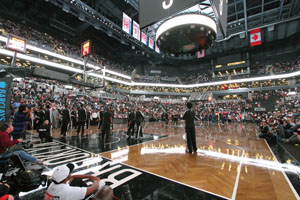 |
Size restrictions at the site required a tight seating bowl.
Photo by: PATRICK E. MCCARTHY
|
At the same time, the arena’s high level of finishes — terrazzo floors on both the lower and upper concourses, full ceilings in the suites with no exposed pipes — speaks to Brooklyn’s vision for also developing a higher-end building.
The conservative look extends to the sponsor zones, subtly branded throughout the arena. Projection lighting on to the main concourse, a nice twist, provides additional branding for partners such as Ticketmaster, which holds naming rights to the main hallway.
The seating bowl itself is one of the tightest in sports for a building its size (17,732 seats for basketball). It is a function of the restrictions in square footage on an urban site and the budget for an arena with hard construction costs of $500 million, Johnson said.
As a result, the upper-deck concourse, called the MetroPCS Upper Pavilion, gets cramped during breaks in the action. The corners upstairs average 12 feet in width, and for the first preseason game, Oct. 15, there were bottlenecks at halftime as fans spilled out to the concession stands.
The tradeoff is that fans are situated closer to the action. To date, the feedback from Nets season-ticket holders has been that “we probably undersold how great these locations are,” Mangione said.
The arena’s first level of suites is 26 rows from the floor. To date, the Nets have sold about 80 percent of the 101 total suites and are approaching 11,000 full-season tickets sold.
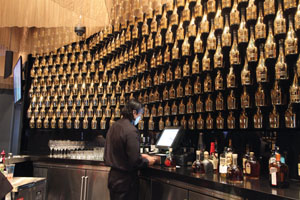 |
The Geico Atrium, (top) where most fans enter the building, leads to a “grand entrance” offering a view of the bowl; patrons of The Vault bunker suites have access to a champagne bar.
Photos by: PATRICK E. MCCARTHY
|
Team officials feel good about those numbers, considering all the new sports venues that have opened in Greater New York over the past five years, Mangione said.
The average price for a suite is $287,000 a year with five-, seven- and 10-year terms. The cost of a suite covers most events, including concerts, family shows and, this year alone, 25 college basketball games in a part of New York that has spawned some of the sport’s greatest stars.
“We were out there selling at the same time when everyone was opening their building,” Mangione said. “Yankee Stadium, Citi Field, [MetLife Stadium], all that was real and tangible, and we were still selling a dream at that point.”
“We got off to a quick start and then we slowed up a little bit between redesigns and changes,” he said. “What really helped us the last six months is when we started our programming … all the different events, that’s what really brought us home.”
The 11 suites inside the Vault, the arena’s bunker suite area at event level, sell for $550,000 a year. Seven of the nine Vault suites available for long-term lease have been sold, Mangione said.
The remaining two suites are reserved for team use. The same is true for the Chairman’s Room, a Vault space sponsored by High Point Solutions, where Nets ownership can entertain senior-level executives with Frank Sinatra’s velvet tones wafting in the background.
The lounge inside the Vault’s common area has a champagne bar, and those patrons can buy fine jewelry inside a small room off to the side of the space. American Brilliance, a New
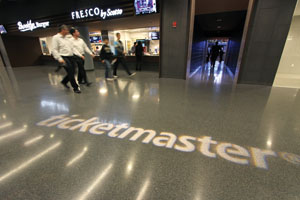 |
The Honda Club (top) sits at one end of the arena; projection lighting on the main concourse provides additional branding for Ticketmaster.
Photos by: PATRICK E. MCCARTHY
|
York jeweler, signed a 10-year lease with the arena.
The Nets had no problem marketing the arena’s 40 loge boxes, groups of four seats at stage end with counter space and small televisions. The average ticket price of $185 a seat per game covers the cost of food and non-alcoholic beverages. The loges sold out in three weeks, Mangione said.
“We priced it right,” he said. “We sent out one direct-mail piece, but we had such a big database of people who were either interested in high-end products or got shut out of some of the better floor seats.”
Outside of Barclays, the bank holding the arena’s naming rights, Calvin Klein has the greatest exposure among founding partners. The luxury apparel maker sponsors the VIP entrance.
From there, whether it’s Woody Allen, Sting and Michael Douglas attending the Streisand show or one of the 700 courtside seat holders, they take the Calvin Klein elevator down to event level for dinner and drinks at the Calvin Klein Courtside Club.
Similar to other NBA arenas, a floor-to-ceiling glass wall in the club provides a view of the Nets players as they walk to and from the court.
On the technology front, Barclays Center stamped Cisco’s StadiumVision IPTV product with its own brand called BCTV. For every event, the arena runs a half-hour program distributing content tied to all events at the facility with advertising wrapping those images.
The Nets Shop by Adidas, the first team store in the club’s 45-year history, overflowed with customers for the first home preseason game. The Nets, with their new black-and-white look, have become a lifestyle brand in part because of the ties with entertainer Jay-Z, a Nets minority owner, Mangione said.
“That was the ultimate goal, and we think we nailed it from that perspective,” he said. The store, run by Adidas, is open seven days a week.
The arena’s retail component extends to storefronts occupied by Rocawear, MetroPCS, Starbucks and Elbow Room, a macaroni and cheese eatery. It’s another brand the Nets want to build up with more retail deals to be announced soon, Yormark said.


